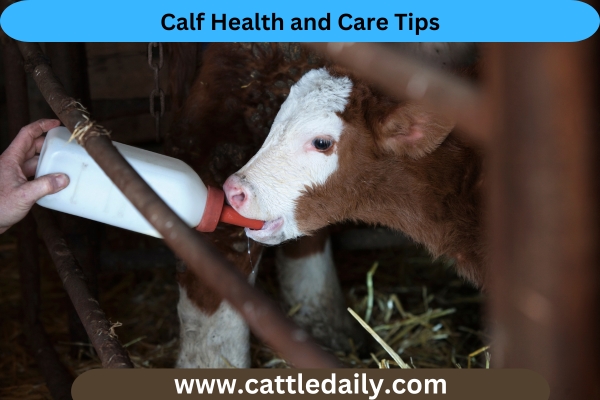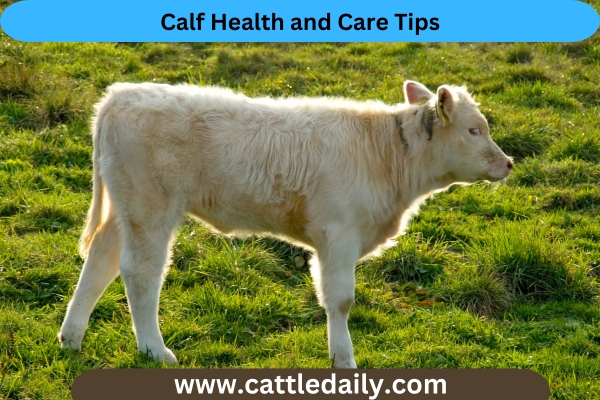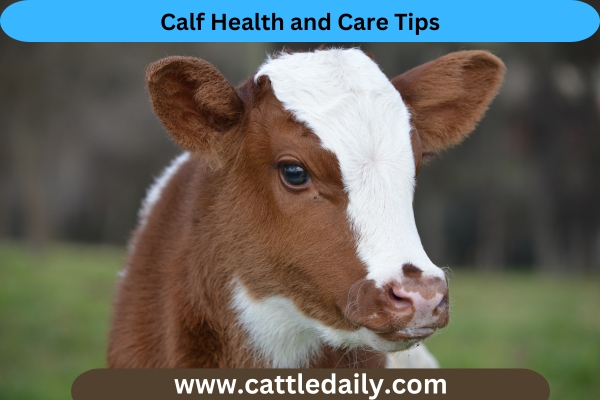Calf Health and Care Tips
Raising robust, thriving calves is essential to any cattle operation. Calves that get off to a strong start have much better odds of reaching their full growth and production potential down the road.
However, calves are fragile, and issues like scours, pneumonia, and other setbacks can quickly derail their progress. The good news is that paying close attention to key areas of calf care can set them up for success.
This includes nutrition, housing, low-stress handling, and more. In this blog post, some key tips and techniques for calf health and care. By following some fundamental guidelines, you can give your calves the best shot at growing into healthy, productive herd members.
15 Calf Health and Care Tips
1. Choose Healthy Breeding Stock
The health of a calf starts before it’s even born. Select breeding stock that is in peak condition – neither too thin nor overweight. Avoid breeds that are prone to calving difficulties.
The dam should have a proper mineral intake and be up-to-date on vaccinations. This gives the calf antibodies through the colostrum. The sire should also come from hardy, robust genetics.
2. Provide Proper Colostrum Intake
The first milk or colostrum from the dam provides essential antibodies and nutrition for newborn calves. Calves should ingest at least 2-3 quarts of high-quality colostrum within the first 6 hours of life. Test colostrum quality with a Brix refractometer.
Anything over 22% is excellent. If the dam’s colostrum is low, supplement with frozen quality colostrum. Feed colostrum with a bottle or esophageal feeder if needed.
3. Sanitize the Calving Area
The calving area should be clean, dry, and well-bedded. Move the pregnant cow into the area 1-2 weeks before her due date. Disinfect any calving equipment like chains or calf pullers. Thoroughly clean and disinfect the area between calves. This prevents the spread of disease-causing organisms to the newborn.
4. Dip the Navel
Dip the newborn calf’s navel cord in a 7% iodine solution as soon as possible after birth. This prevents bacteria from entering through the umbilical cord and causing joint ill or other infections. Be sure the cord is fully submerged in the dip cup. Reapply if the area is wet or dirty.
5. Feed Colostrum Replacer if Needed
If the dam’s colostrum is poor quality or unavailable, use a colostrum replacer within 12 hours of birth. Look for brands with at least 100-150 grams of globulin protein per dose. Follow label directions carefully. Do not try to stretch the replacer too far – feed the recommended amounts based on calf weight.

6. Give Selenium & Vitamin E
Most calves are born deficient in Vitamin E and selenium due to low levels in their dams. Inject newborns with selenium and vitamin E or feed a supplement right away to prevent deficiencies. Deficiencies can lead to white muscle disease, weak calves, and a higher risk of infection.
7. Control Scours
Scours or calf diarrhea is the main cause of pre-weaning death in calves. It leads to rapid dehydration and electrolyte imbalances. Controlling infectious causes through colostrum, sanitation, and vaccination is key.
Also, treat all scour cases promptly with oral electrolytes and anti-diarrheal medications. Isolate sick calves and disinfect them carefully between animals.
8. Avoid Cold Stress
Chilled newborns have weaker immune systems and are more prone to scours and pneumonia. Dry calves immediately after birth and provide deep dry bedding.
Use calf jackets or warming boxes only for brief periods for very cold, wet newborns – prolonged use weakens their ability to thermoregulate long-term. Provide draft-free, well-ventilated housing.
9. Feed a Milk Replacer Properly
For bucket or bottle feeding, use a quality all-milk protein replacer. Mix according to label directions. Feed calves 2-3 quarts twice daily. Keep equipment clean to avoid bacterial contamination and ulcers. Wean gradually over 7-10 days once calves eat 2 pounds of starter daily.
10. Ensure Adequate Ventilation
Proper ventilation removes respiratory irritants like dust, ammonia, and excess moisture from calf housing. Provide at least 20 air exchanges per hour. Orient buildings to take advantage of prevailing winds.
Use exhaust fans, curtains, and vents appropriately for your climate. This promotes respiratory health.

11. Monitor Growth
Weigh calves regularly – aim for doubling birth weight by 60 days. Provide high-quality forage once rumen development starts around 3 weeks of age. Observe eating habits and notice any calves falling behind. Be attentive to signs of illness and treat promptly. Separate weaker animals and provide extra care.
12. Follow Vaccination Protocols
Work with your veterinarian to design an effective vaccination program for your operation. This builds critical immunity against common bovine respiratory and enteric pathogens. Give initial vaccination series at the appropriate age, then follow with boosters per label directions. Properly storing and administering vaccines is key for efficacy.
13. Provide Clean Water
Fresh, clean water is essential for hydration, feed digestion, and health. Allow 1-2 gallons daily for young calves. Use clean buckets and rinse thoroughly between uses. Break up ice in winter if needed to ensure constant access. Add electrolytes during scour outbreaks for additional hydration support.
14. Limit Stress
Avoid overcrowding, loud noises, dogs, and other stressors. Handle calves gently – do not drag or pull them. Castrate and dehorn following approved protocols for pain management.
Providing proper nutrition, sanitation, and a low-stress environment will go a long way toward raising thriving, healthy calves.
15. Housing Tips
- Provide individual hutches or pens to house calves separately until at least 2 months of age. This prevents disease spread and allows monitoring of feed intake.
- Clean hutches and pens thoroughly between calves. Use a disinfectant to kill disease-causing germs. Remove all organic matter first when cleaning.
- Use deep bedding like straw in hutches and pens. Dry bedding keeps calves clean and warm.
- Allow calves outdoor access or provide proper ventilation indoors. Good air exchange reduces respiratory illness risk.
- Give shelter from extreme cold, heat, wind, and precipitation. Tarps, calf jackets, or hutch covers can provide extra protection.
- Position hutches to face south with openings away from prevailing winds. This allows sunshine in and bad weather out.
Other Calf Care Tips
- Handle calves gently and calmly. Avoid dragging, pulling or yelling. Approach slowly when entering pens.
- Bottle or bucket feed at consistent times daily. Feed the same way each time to avoid bloat risks.
- Brush and groom calves to keep them clean. This stimulates circulation and provides comfort.
- Socialize calves through gentle contact and exposure to caretakers and routines. This reduces stress.
- Provide calf toys like balls, scratching posts and sturdy brushes for enrichment. Mental stimulation aids development.
- Talk calmly and soothingly to calves when feeding and caring for them. Comforting voices and touch are reassuring.
- Wean calves gradually over 7-10 days once eating 1-2 pounds of starter feed daily. Mix milk and starter during weaning.
- Work with a veterinarian to design health protocols for your calves including vaccination, parasite control, and more.
Conclusion:
Following through on the essentials of newborn and young calf care pays great dividends down the road. While calves may seem delicate, taking the right steps in those critical early weeks and months helps get them off to a strong start. Give them ample, high-quality colostrum and milk.
House them in clean, dry, well-ventilated pens. Handle gently and limit stress. Control infectious disease through vaccination, sanitation, and isolation. Weigh regularly to ensure adequate growth.
By making calf health a priority now, you are investing in the future productivity and profitability of your herd. Raising robust calves takes diligence and care, but the long-term benefits make it well worth the effort. Learn more about farming tips and guides.
FAQs:
Q: How much colostrum should a newborn calf receive?
A: Calves should receive 2-4 quarts of high-quality colostrum within the first 6 hours of life. This provides essential antibodies and nutrition. Test colostrum with a Brix refractometer and supplement if low quality.
Q: What is the best way to prevent calf scours?
A: Preventing scours starts with ample colostrum, keeping pens and feeding equipment clean, and following vaccination protocols. Also isolate any scouring calves promptly to prevent spread.
Q: What is the ideal housing temperature for young calves?
A: Calves do best at temperatures around 60-75°F. Use calf jackets or warming boxes only for newborns in extremely cold conditions. Ensure adequate ventilation is always provided.
Q: When should I wean calves from milk?
A: Start weaning once calves eat 1-2 lbs of starter feed daily. Gradually mix milk and starter over 7-10 days, reducing milk until calves are just on starter. Watch closely to ensure calves continue gaining weight.
Q: How can I tell if a calf is sick?
A: Signs of illness include lethargy, loss of appetite, coughing, nasal or eye discharge, diarrhea, dehydration, and fever. Isolate any suspect calves promptly. Consult a vet for diagnosis and treatment.
Q: How much space does a calf need?
A: Individual hutches should be at least 6 x 8 feet. Outdoor pens should provide at least 100-150 sq ft per calf. Overcrowding causes stress and disease spread.
Q: When should I vaccinate calves?
A: Discuss with your veterinarian, but first vaccination is typically around 2 months old, with boosters at 4 weeks and 6-8 weeks later per vaccine label. Proper storage and administration is key.
Q: How much feed should I give bottle-fed calves daily?
A: Most calves need 16-20% of body weight in whole milk or milk replacer per day, fed in at least 2 feedings. So a 100 lb calf would receive 16-20 lbs total daily.


